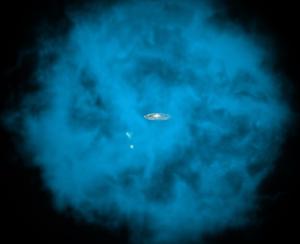Post
Missing Mass Mystery
16 July 2013
This year data from the Planck satellite released the most precise observations of the cosmic microwave background. The results tell us that about 68.3% of the universe is dark energy, 26.8% is dark matter, and 4.9% is baryonic matter. Baryonic matter is the regular matter that makes up stars and planets and me and you. It is called baryonic because protons and neutrons which form the nuclei of atoms are known as baryons. (There are other, more exotic, baryonic particles, but protons and neutrons are the most common) So all the atoms and molecules we are familiar with are baryonic matter.
Usually when this topic is mentioned, it’s emphasized that only about 5% of the universe is made up of stuff we understand, since dark matter and dark energy are still a bit of a mystery. But there is a lesser known mystery, that of the missing baryons. We know that 4.9% of the universe must consist of baryonic matter, but when we look around at galaxies and and such, we only observe about 10% of the baryonic matter that exists. That’s because only about 10% of it is concentrated in stars or nebulae that can be easily observed. Another 40% or so can be observed has diffuse clouds within galaxies. So where is the rest of the baryonic matter?
It’s generally thought that the remaining regular matter must be thinly spread out in the spaces between galaxies and between clusters of galaxies. Since galaxies tend to clump together in groups, that leaves a great deal of space in between. If even the most tenuous clouds of gas exists in those gaps, that could account for the missing matter. This matter would be so thinly distributed that it would be very difficult to detect.
 NASA/CXC/M.Weiss
NASA/CXC/M.WeissThere is some evidence to support the idea, however. One of these come from x-ray observations of a hot gas halo surrounding our galaxy.1 You can see a visualization of this halo in the image here. This halo is very diffuse (and not related to the so-called dark matter halo), but is heated by shock waves and supernovas to temperatures high enough to emit faint x-rays. From observations, the mass of this halo is estimated to be about the same as the mass of the visible galaxy. This gives credence to the idea that lots of regular matter is diffusely spread.
There may soon be another source of evidence as well. You may have heard recently of the detection of very short (lasting only milliseconds) intense radio bursts originating from outside our galaxy. We aren’t entirely sure what causes these bursts, but their intensity and duration provide an excellent probe of intergalactic baryonic matter. This is because radio waves are distorted by their interaction with ionized gas. So as we learn more about these ultra short radio bursts, particularly their location, we may be able to use them to observe diffuse intergalactic gas.
With luck, the mystery of baryonic matter may soon be solved.
Gupta, A., et al. “A huge reservoir of ionized gas around the Milky Way: accounting for the missing mass?.” The Astrophysical Journal Letters 756.1 (2012): L8. ↩︎